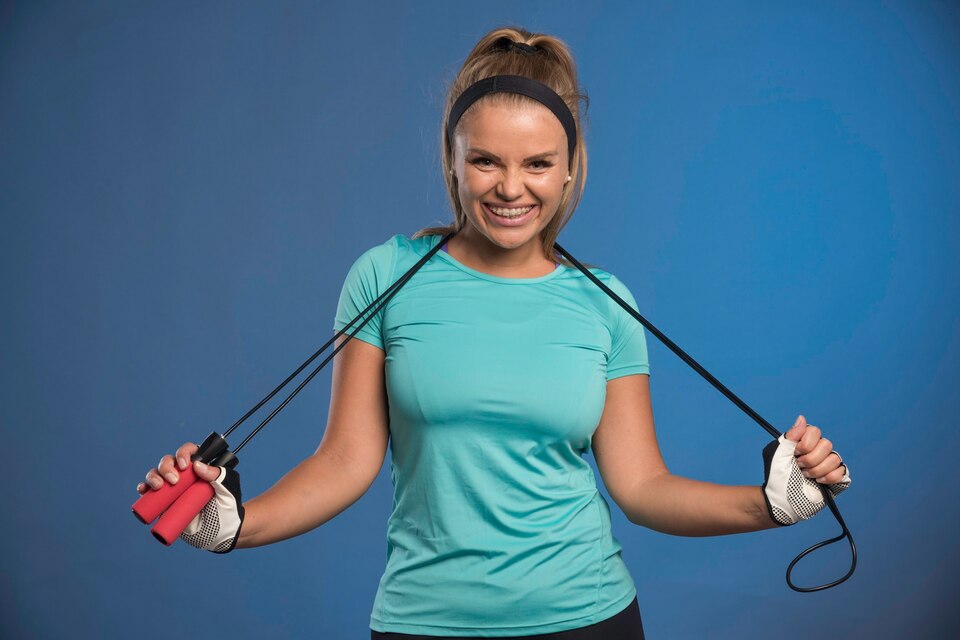Jump rope, frequently disregarded in exercise, is lively and convenient. Weightlifting and jogging are popular among fitness enthusiasts who want a varied, high-intensity regimen. However, the jump rope shines as a miracle workout that produces fast, powerful effects without equipment or room.
Its low-impact, high-intensity nature makes it great for people who want to optimize their exercises while retaining flexibility. Jumping rope for weight reduction is a transformational training routine with many advantages. This dynamic workout, frequently overlooked, has distinct benefits for weight loss and well-being.
1. Burn Calories Efficiently:
Jump ropes are calorie burners and aerobic tools. It burns 200 calories in 15 minutes, making it one of the most effective weight reduction workouts. The jump rope’s cardiovascular involvement and full-body muscular stimulation make it a thermogenic marvel that burns fat quickly.
2. Full Body Workout:
Jumping rope works almost every muscle area, unlike many other workouts. Jumps target several muscles, from arms and belly to legs and glutes, for a complete exercise. Jumping rope challenges the body, building muscle and losing weight.
3. Increase In Running Speed:
Jump rope in your warm-up may boost running pace, athletes. According to research, jumping rope before running improves leap, sprint, and running speed. Jump rope is helpful for athletes because of its particular features.
4. Strengthen Bone Density:
Jumping rope improves bone and cardiovascular health. Each leap strengthens bones and knees by depositing minerals and calcium. This builds bone density, making it more resistant to jumping and improving skeletal health.
5. Improved Muscle Endurance:
Muscle endurance is critical to long-term training. Jumping rope requires rhythmic action, which builds muscular endurance. Whether setting a duration or progressively increasing jumping time, this exercise improves fitness by building muscular endurance.
6. Increased Agility:
Jumping rope requires agility and is energetic. Rapid leap transitions and steady landings improve balance and coordination. Skill improves beyond jump rope, affecting other physical exercises and everyday motions.
7. Improved Cardiovascular Health:
Jumping rope is excellent cardio, raising the heart rate and improving circulation. Jumping’s rhythmic nature increases heart and body blood flow. Jump rope reduces blood vessel blockages and improves circulatory function, improving cardiovascular health.
8. Improved Coordination:
Jump rope requires sophisticated footwork and coordinated wrist motions, which improves muscle and mental coordination. Coordination abilities improve as jump rope levels become harder because each leap requires rapid, precise movements. Beyond the exercise, this synchronization improves everyday life.
9. Reduced Risk Of Injury:
Jumping rope requires upper- and lower-body coordination, increasing awareness. This increased awareness reduces exercise injury risk. Jumping rope promotes conscious movement, reducing exercise-related injuries.
10. Boosts Mood:
Jumping rope is enjoyable, diversified, and good for your mood. With one-foot leaps, alternating leg jumps, high knees, hip twists, and crossovers, this workout keeps people guessing about the next muscle it will target. The variation in the exercise pushes the body and adds fun, making training more enjoyable.
How To Combine Jumping Rope Into Your Workout
Adding a jumping rope to your exercise boosts its intensity and effectiveness. This adaptable workout may be smoothly incorporated at numerous points, making a healthier, more active lifestyle efficient and fun.
1. Warm-up:
Start your exercise with a lively 5-minute jump rope routine. This is a cardiovascular warm-up and muscle and joint preparation for the activities. Jumping rope raises your heart rate, blood flow, and fitness for more severe exercise.
2. Finisher:
Finish your exercise with a high-intensity jump rope to make a lasting impression. Jumping rope after a workout keeps your heart rate up, burning calories. This increased effort at the end boosts your workout’s efficacy.
3. Sedentary Break:
Jump rope during inactive breaks to reduce the risks of sitting. Take a break from work or home to jump rope. Injecting bursts of physical exercise into a sedentary lifestyle counteracts the detrimental effects of extended sitting and boosts energy.
4. Mid-workout:
Maintain an increased heart rate with jump rope intervals between weight training sessions. Jump rope briefly between workouts. This effortlessly integrates aerobic activity with strength training to increase calorie burn.
Use jumping rope strategically throughout your exercise to get its full advantages. Jump rope is a flexible and effective warm-up, finisher, sedentary break activity, and mid-workout interval. For a well-rounded and robust training experience, choose the appropriate times to include this dynamic exercise into your workout routine easily.
Precautions To Take While Jumping Rope
Jumping rope is an excellent and fun workout, but like any physical activity, it involves safety precautions. Jumping rope with these measures will maximize benefits and minimize injury risk.
Proper Form:
Standing in the center of the rope with both feet and gripping the grips at chest height with straight arms is good form. Making sure the rope ends reach your armpits shows the right length. A safe and productive jump rope exercise starts with this form.
Warm-up:
A 5-minute warm-up should precede rigorous jump rope training. Warming up boosts muscular blood flow suppleness and decreases stresses and injuries. Dynamic stretches prepare your body for rhythmic, high-impact leaping.
Hydration:
Hydrate between sets with electrolyte-rich water. Cardiovascular activity like jumping rope may increase perspiration and fluid loss. Staying hydrated throughout exercise helps maintain energy, reduce cramps, and improve overall health.
Appropriate Attire:
Wear shock-absorbing shoes or training shoes for exercise. Preventing leaping injuries requires ankle protection. To jump comfortably, ladies need a robust sports bra with enough support.
Timing:
After eating, wait 45 minutes before jumping rope. Jumping on a full stomach may be uncomfortable and hinder your performance. The time between meals and jump rope sessions optimizes digestion and decreases nausea and cramps.
Conclusion
Jump ropes are exciting and easy weight reduction and workout tools. Its unique ease and high-intensity combination make it a top option for all fitness levels. Jump ropes benefit warm-ups, finishers, inactive breaks, and mid-workout intervals. Jump rope may increase heart rate, burn calories, and build a healthier, more agile physique if safeguards are taken and this easy but intensive cardio activity is included. Jump rope isn’t simply a kid’s game—it alters workouts and yields astonishing results.










